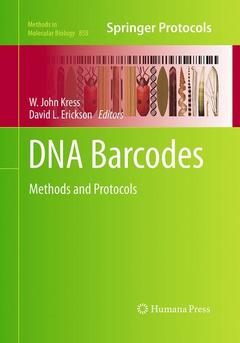Description
DNA Barcodes, 2012
Methods and Protocols
Methods in Molecular Biology Series, Vol. 858
Coordinators: Lopez Ida, Erickson David L.
Language: English
Publication date: 08-2016
Support: Print on demand
Publication date: 06-2012
470 p. · 17.8x25.4 cm · Hardback
Description
/li>Contents
/li>Comment
/li>
A DNA barcode in its simplest definition is one or more short gene sequences taken from a standardized portion of the genome that is used to identify species through reference to DNA sequence libraries or databases. In DNA Barcodes: Methods and Protocols expert researchers in the field detail many of the methods which are now commonly used with DNA barcodes. These methods include the latest information on techniques for generating, applying, and analyzing DNA barcodes across the Tree of Life including animals, fungi, protists, algae, and plants. Written in the highly successful Methods in Molecular Biology? series format, the chapters include the kind of detailed description and implementation advice that is crucial for getting optimal results in the laboratory.
Thorough and intuitive, DNA Barcodes: Methods and Protocols aids scientists in continuing to study methods from wet-lab protocols, statistical, and ecological analyses along with guides to future, large-scale collections campaigns.
I. Introduction
1. Introduction (W. John Kress & David L. Erickson, Smithsonian, USA)
II. DNA Barcodes for the Tree of Life
2. Introduction to Animal DNA Barcoding Protocols
Lee A. Weigt, Amy Driskell, Andrea Ormos, Chris Meyer, and Allen Collins
3. DNA Barcodes for the Tree of Life – A. Animals - Insects
John James Wilson and Scott E. Miller
4. Barcoding Methods for Invertebrates
Nathaniel Evans & Gustav Paulay
5. DNA Barcoding of Amphibians and Reptiles
Miguel Vences, Zoltán T. Nagy, Gontran Sonet, Erik Verheyen
6. DNA Barcoding Fishes
Lee A. Weigt, Amy Driskell, Andrea Ormos
7. DNA Barcoding Birds: from Field Collection to Data Analysis
Darío A. Lijtmaer, Kevin C. R. Kerr, Mark Y. Stoeckle and Pablo L.Tubaro
8. DNA Barcoding in Mammals
Natalia V. Ivanova, Elizabeth L. Clare, Alex V. Borisenko
9. Methods for DNA Barcoding of Fungi
Ursula Eberhardt
10. Methods for DNA Barcoding Photosynthetic Protists Emphasizing the Macroalgae and Diatoms
Gary W. Saunders and Daniel C. McDevit
11. DNA Barcoding Methods for Land Plants
Aron J. Fazekas, Maria L. Kuzmina, Steven G. Newmaster, and Peter M. Hollingsworth
III. Generating DNA Barcode Data
12. Field Information Management Systems (FIMS) for DNA Barcoding
Deck, John; Gross, Joyce; Stones-Havas, Steven; Davies, Neil1; Shapley, Rebecca & Meyer, Christopher
13. Laboratory Information Management Systems (LIMS) for DNA Barcoding
Meaghan Parker; Steven Stones-Havas, Craig Starger and Chris Meyer
14. DNA Extraction, Preservation and Amplification
Thomas Knebelsberger and Isabella Stöger
15. DNA Mini-barcodes
Mehrdad Hajibabaei and Charly McKenna
16. Next Generation Sequencing: Multiplexing Multiple Barcode Amplicons into Single 454 Run
Ryuji Machida and Nancy Knowlton
IV. Applications of DNA Barcode Data
17. The Practical Evaluation of Barcode Efficacy
John L. Spougeand Leonardo Mariño-Ramírez
18. Plant DNA Barcodes, Taxonomic Management and Species Discovery in Tropical Forests
Christopher W. Dick and Campbell O. Webb
19. Construction and Analysis of Phylogenetic Trees using DNA Barcode Data
David L. Erickson and Amy C. Driskell
20. Phylogenetic Analyses of Ecological Communities Using Barcode Data
Nathan G. Swenson
V. Case Studies on DNA Barcodes
21. DNA Barcodes: FISH-BOL, a Case Study
Robert D. Ward
22. Generating Plant DNA Barcodes for Trees in Long-term Forest Dynamics Plots
W. John Kress, Ida C. Lopez, David L. Erickson
23. Future Directions
David L. Erickson and W. John Kress
A compendium of the latest information on generating, applying, and analyzing DNA
Provides step-by-step detail essential for reproducible results
Contatins key notes and implementation advice from the experts
These books may interest you

DNA Cloning and Assembly Methods 116.04 €



